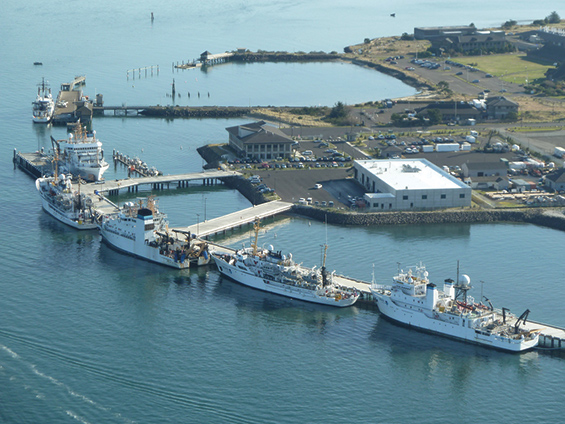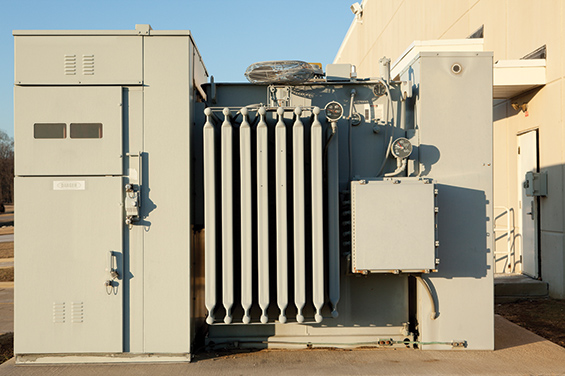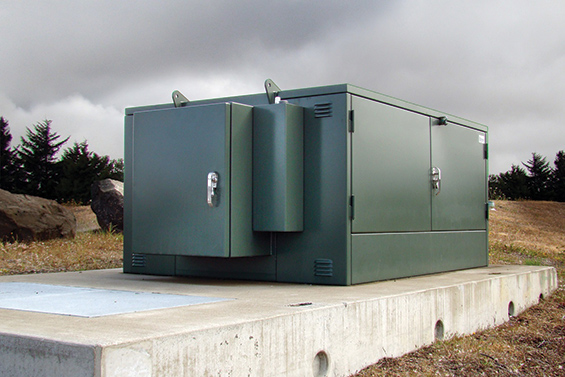Central Lincoln People’s Utility District storm-hardened switchgear weathers the elements to help power NOAA’s new Pacific Fleet Headquarters; 6-way SCADA VFI with high-speed automatic transfer to provide reliable 15 kV power distribution in a corrosive salt air coastal environment of high moisture and humidity.
The National Oceanic and Atmospheric Administration’s Marine Operations Center-Pacific (NOAA MOC-P) provides nearly 41,000 square feet of state-of-the-art LEED-certified offices and warehouses supporting the agency’s Pacific Fleet operations. Situated adjacent to Oregon State University’s Hatfield Marine Science Center at the head of Yaquina Bay, the new MOC-P facility in Newport, Oregon (Figure 1), is home port to four NOAA research/survey ships as well as supporting five other vessels operating out of Alaska and Hawaii.

Figure 1. The NOAA MOC-P facility in Newport, Oregon provides global communications
and high-performance computing operations on a 24/7 basis.
Mission-critical operations demand high power availability
Since 2011, the Marine Operations Center has not only provided administration, engineering and maintenance for NOAA’s Pacific fleet, but a host of other mission-critical operations underscore the high value of this facility to the maritime operations of the entire Pacific Rim. This includes, but may not be limited to:
- Producing nautical charts
- Deploying and maintaining buoys for gathering oceanographic information, weather data and generating tsunami warnings
- Managing commercial marine fish stocks
- Collecting data relative to climate and protection of marine life, coral reefs and historic shipwrecks
In the performance of its routine activities, the NOAA center’s need for global communications and high-performance computing underscores the demand for reliable power from the local utility to the facility on a 24/7/365 basis. Complicating matters is the environment in which the facility operates. With an average annual rainfall of almost 70 inches, Newport is also no stranger to dense coastal fog, temperature variations, and other coastal weather phenomena. Corrosive salt air environments, too, pose special challenges to utilities in keeping the switchgear and other equipment running at peak performance under operating conditions that often exceed manufacturers’ specifications. This was part of the challenge faced by Central Lincoln People’s Utility District (PUD) during the construction of the new NOAA facility in the area known locally as South Beach.
Central Lincoln connects the Marine Center to the grid
Founded in 1943 in Lincoln County, Oregon, Central Lincoln PUD is sourced primarily by hydroelectric power from the Bonneville Power Administration dams on the Columbia River and its tributaries. Now serving over 34,000 residential and 4,000 commercial customers over a 700 square mile service territory, Central Lincoln PUD was faced with extending its power distribution line from an existing substation to the new NOAA facility.
“Shortly after the Port of Newport was selected to be the new home port for the NOAA Pacific fleet, Central Lincoln was contacted about the new facility’s need for highly reliable, underground electric service,” says Bruce J. Lovelin, Chief Engineer/Systems Engineering Manager for Central Lincoln PUD.
The utility’s existing switch providing three 200A three-phase ways was deemed insufficient to supply adequate power to both existing customers and the new facility from the same substation. What was needed was a solution that could not only handle the increased power load but provide ruggedized, longer-life operation suitable to Newport’s harsh environmental conditions. In this case, ‘storm-hardened’ switchgear was the answer.
What does it take to ‘Storm Harden’ switchgear?
While no ‘official’ classification yet exists for this category of switchgear, a working definition I am comfortable with – “actions taken to secure a system against the ravages of unusually strong storms” – speaks to the need for ruggedizing equipment design, both mechanically and electrically, to withstand extreme environmental conditions while operating reliably over an extended service life. In terms of severe weather impacts on the switchgear itself, the essential hardening elements described below would provide similar levels of survivability for what Trayer Engineering calls ‘hurricane and inland storm-rated switchgear.’

Figure 2. Most electrical switchgear is designed for operation in relatively benign outdoor environments. Classic failure points include bolts, door gaskets and other areas where liquid or particulate ingress can destroy the switch or breaker circuitry.
As opposed to non-hardened gear (Figure 2), there are five important elements that contribute to storm-hardening the design of medium voltage switchgear for both pad-mount and below-grade installations:
- Corrosion Resistance – under hazardous conditions, mechanical degradation caused by corrosion can cause a unit to fail in less time than that projected by a manufacturer. Under ‘normal’ conditions, ordinary mild steel, even if painted, will corrode and fail. It cannot stand up to exposure to chemical attack, whether from the sea or even fertilizers from agricultural use or domestic lawn sprinkler runoff. Type 304 surgical stainless steel, an Austenitic alloy containing 18 to 20 percent chromium and 8 to10 percent nickel, should be used for enclosure fabrication because of its superior corrosion resistance
- Welded Seam Construction and Hermetically Sealed Cavity – welded seams provide greater integrity than bolted enclosures that are susceptible to water and particulate ingress through leakage as the equipment ages. Hermetic sealing prevents the loss of insulating mediums such as liquid and gas. A truly sealed cavity will meet an IP68 rating for solids and liquids.
- Functional Submersibility – even if a welded tank is able to survive a storm surge or heavy winds, mechanical and electrical components such as controls are at risk of losing their functionality, rendering an entire unit, and even grid, obsolete. All componentry, such as SCADA controls and motor operators, must be able to survive adverse conditions
- Robust Electrical Design – critical internal components, such as switches and interrupters, must be able to survive multiple concurrent fault and overcurrent conditions, such as those present in storms and natural disasters. Vacuum bottle technology greatly reduces the risk of catastrophic failure.
- Ease of Operation – protecting the lives and wellbeing of the line crew operating high voltage equipment is crucial to the design of switchgear. While working in low visibility or adverse weather conditions, it is important that equipment is clearly labeled, easy to operate and built with safety features such as visible disconnects that allow for a visual indication as to the status of the unit.

Figure 3. Trayer 3805 series medium-voltage electrical switchgear installed by Central Lincoln PUD at the NOAA Pacific Fleet Headquarters provides high-speed automatic transfer and doublesided access. The unit’s corrosion-resistant 304 stainless steel enclosure requires no maintenance and prevents rusting in harsh marine and inland storm environments. Note placement of boulders as a landscape barrier to protect the pad from vehicular traffic.
Operational characteristics
Also shown in Figure 3, the switchgear takes advantage of the corrosion resistance provided by its Type 304 stainless steel enclosure that prevents rusting and requires no maintenance, even in harsh, salt air coastal environments like Newport.
Operationally, the unit’s primary feeders consist of two switchable 600A ways – one closed and one open during normal operation. A major advantage of having both power feeds coming from the same utility substation, as opposed to separate substations, is the seamless transfer that results from the phasing being identical on both feeds.
The switchgear’s fully automated supervisory control and data acquisition (SCADA) switch performs high-speed automatic transfer of the primary power feed circuits to the secondary source in just under 10 cycles – well within the normal ride-through of typical electrically powered equipment today. In addition to open mode, closed transfer mode is also selectable by the user. This allows transfer back to the primary source after power is restored. Other performance characteristics of the 15 kV liquid-insulated switch include:
- Two switched ways; three 200A VFIs and one 600A VFI
- 10,000 load break switch operations at full load, including 8,000 for the VFI
- 600A continuous current and load switching
- One-minute withstand capability at 34 kV (60Hz) for both load switch and VFI
- Standard 95 kV BIL (impulse insulation) for 15 kV-rated switchgear
Fine-tuning the transformer protection relay
Of note in this application is how the switchgear’s SEL- 487E control unit, Central Lincoln’s preferred relay, has been implemented. Manufactured by Schweitzer Engineering Laboratories of Pullman, Washington, the industry-leading unit was originally designed for classic, high-reliability transformer protection applications in utility substations. However, due to the highly adaptable, I/O-intensive capability of the device, the NOAA facility application represents the first known use of the -487E for new, highly specialized distribution automation functions that were neither considered by the manufacturer, nor previously implemented in the industry.
The customization of the -487E’s firmware takes advantage of the control unit’s ability to simultaneously protect four different three-phase circuits. In operation, this allows the same control platform to provide high-speed transfer functions, fiber or radio communications, an optional GPS clock and true synchro-phasing to ensure that closed transitions for both feeds are completed in exact synchronicity relative to the phasor.
“The unit has been in operation for about a year and a half, and Central Lincoln engineering staff and operations personnel are all very satisfied with the performance of the switch,” Chief Engineer Lovelin explains. “Electrically it allows us the flexibility to serve the critical area loads from two sources.”
Conclusion
Central Lincoln PUD recognized the need for storm-hardened switchgear to meet the requirements of the expanded NOAA facility in Newport, OR. The switchgear provides a reliable and long-term solution in coastal environments like this but also offer long-term reliability whenever the equipment may be subjected to wind, dust, flooding, and other common conditions.
About the Author
 Tom Trayer is Northwest Regional Manager for Trayer Engineering Corporation. He has over thirty years of education and experience in the manufacturing, engineering and application of medium voltage switchgear.
Tom Trayer is Northwest Regional Manager for Trayer Engineering Corporation. He has over thirty years of education and experience in the manufacturing, engineering and application of medium voltage switchgear.








